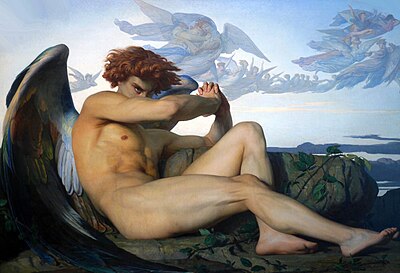The Fallen Angel (Cabanel)
| The Fallen Angel | |
|---|---|
 | |
| Artist | Alexandre Cabanel |
| Year | 1847 |
| Medium | Oil on canvas |
| Location | Musée Fabre, Montpellier |
The Fallen Angel (French: L'ange déchu) is a painting by the French artist Alexandre Cabanel. It was painted in 1847, and is now in the Musée Fabre in Montpellier.
Background and Description[edit]
The Fallen Angel is a painting picturing Lucifer as the subject, in a Christian view,[1] posed in a reclined position, yet his body appears tense and flexed,[2] picturing Lucifer nude, covering part of his face, resulting in the only expression visible being through his eyes, which features a single larger-shaped tear on each eye, picturing Lucifer as a relatable and sympathetic figure.[2] The Fallen Angel was one of the first paintings to depict the Devil or Satan as the subject matter, and sources report that the jurists were “shocked” when they saw it.[3][4]
Gallery[edit]
-
Full image of The Fallen Angel.
-
Close-up on Lucifer's face.
-
Wide close-up on Lucifer's face.
-
Full image of The Fallen Angel.
References[edit]
- ↑ "Fallen Angel". Obelisk Art History. Retrieved 2022-09-16.
- ↑ 2.0 2.1 This Provocative Painting Made Everyone Cringe. Here's Why., retrieved 2022-09-16
- ↑ artincontext; artincontext (2022-05-09). ""Fallen Angel" by Alexandre Cabanel - The Famous Painting of Lucifer". artincontext.org. Retrieved 2022-09-16.
- ↑ "Fallen Angel". Obelisk Art History. Retrieved 2022-09-16.
| This article about a nineteenth-century painting is a stub. You can help EverybodyWiki by expanding it. |
This article "The Fallen Angel (Cabanel)" is from Wikipedia. The list of its authors can be seen in its historical and/or the page Edithistory:The Fallen Angel (Cabanel). Articles copied from Draft Namespace on Wikipedia could be seen on the Draft Namespace of Wikipedia and not main one.




